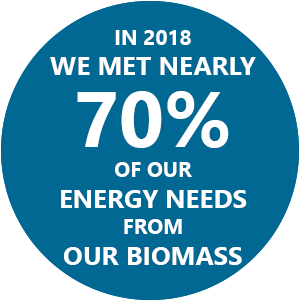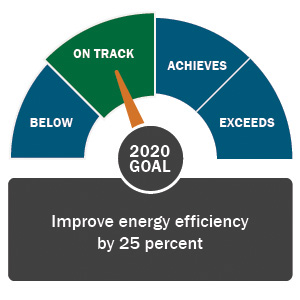 Energy
Energy
Renewable energy at its best
CREATING OUR OWN ENERGY
It takes energy to run a sawmill and make our wood products. Fortunately, we have a steady supply of a renewable, carbon-neutral fuel source in the form of biomass (the bark, chips, wood residuals and other organic byproducts of our manufacturing process).
We meet nearly 70% of our energy needs from our biomass. Quite simply, we turn our residuals into energy — a double win for our bottom line and the environment.
For the remainder of our energy needs, we purchase electricity and fuel to power our wood products mills.
We are committed to reducing energy intensity (energy per unit of product we make) by 25 percent between 2009 and 2020. Some efficiency gains are simple, like turning off lights and equipment not in use, while others require large capital investments to upgrade to new equipment or modify existing machinery. Our capital improvements are required to perform double duty: introducing energy savings while also improving production efficiencies.
By the end of 2018, our energy efficiency improved by 15 percent and we are actively exploring ways to reach our 2020 goal. This year, we are re-engaging with the U.S. Department of Energy's Better Plants Program to help us find additional energy efficiencies.


PROVIDING RENEWABLE ENERGY
Our timberlands provide an important land base for renewable energy production, such as wind and solar power. We partner with reputable industry leaders who take the lead identifying, evaluating, permitting and building projects. After a thorough evaluation and permitting process, we grant easements on our lands to qualified third parties who use our property to create renewable energy and allow us to develop additional revenue.
Currently, we have 401 megawatts of operational wind projects on our timberlands in three states - North Carolina, West Virginia and Maine. Visit this site to learn some fun and interesting wind energy facts.
Additionally, we supply other mills, companies and utilities with woody biomass (the lower-value material such as bark, limbs, chips, residuals and small-diameter trees from thinnings) to be used to produce a renewable, carbon-neutral energy solution and an alternative to fossil fuels. Unlike fossil fuels that add carbon to the atmosphere from nonrenewable geologic sources, carbon associated with the combustion of biomass is part of a natural cycle that maintains a carbon balance. When biomass is burned, the stored carbon — which would have been emitted through natural decay — is released into the atmosphere and reabsorbed by growing forests.
We believe biomass from sustainably managed forests should be a part of renewable energy strategies since it helps reduce our dependence on fossil fuels and contributes to the reduction of greenhouse gas emissions. Forest biomass offers a low-carbon energy solution compared with fossil fuel alternatives while keeping forests healthy by protecting them from insects, disease and wildfire.
Internationally accepted accounting by organizations like the United Nations Intergovernmental Panel on Climate Change acknowledges that the combustion of wood biomass for energy from countries with sustainable forest inventories, such as the United States, does not increase atmospheric carbon.
By using this website, you agree to our Privacy Policy. California residents: See our CCPA Privacy Notice for details on what personal information we collect and for what purposes.
